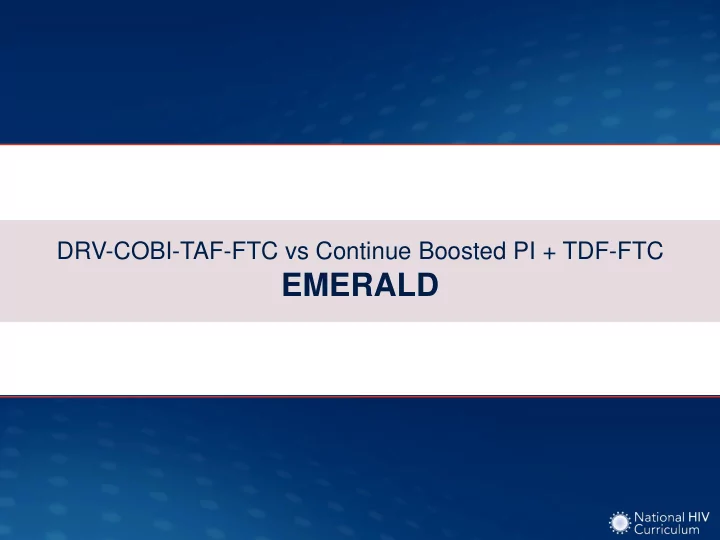

DRV-COBI-TAF-FTC vs Continue Boosted PI + TDF-FTC EMERALD
DRV-COBI-TAF-FTC vs Continue Boosted PI + TDF-FTC EMERALD: Design EMERALD: Study Design • Background : Randomized, open-label, active- controlled, international, phase 3 study evaluating the efficacy and safety of switching to the single-tablet Switch Group regimen DRV-COBI-TAF-FTC versus continuing a boosted PI + TDF-FTC DRV-COBI-TAF-FTC (n = 763) • Inclusion Criteria (n=1,141) 2x - Age >18 - Antiretroviral-experienced 1x - HIV RNA <50 copies/mL for ≥2 months* Continue Group - No prior virologic failure on a DRV-based regimen Boosted PI + TDF-FTC - Virologic failure on non-DRV-based regimen allowed (n = 378) - Taking a PI plus ritonavir or cobicistat - Regimen stable for ≥ 6 months - eGFR ≥ 50 mL/min - Not pregnant or breastfeeding - No HBV or HCV infection *One HIV RNA 50-200 copies/mL within prior 12 months allowed Source: Orkin C, et al. Lancet HIV. 2018;5:e23-e34.
DRV-COBI-TAF-FTC vs Continue a Boosted PI + TDF-FTC EMERALD: Baseline Characteristics EMERALD Study: Baseline Characteristics DRV-COBI-TAF-FTC Boosted PI + TDF-FTC Switch Group Continue Group (n = 763) (n = 378) CD4 Count (cells/mL) 630 624 Time since HIV diagnosis (years) 9.3 8.9 Time since first ART (years) 6.2 5.8 Previous use of >5 ARV’s 59 58 Previous virologic failure 15 14 Boosted darunavir at screening (%) 70 70 Boosted atazanavir at screening (%) 22 22 Boosted lopinavir at screening (%) 8 8 Source: Orkin C, et al. Lancet HIV. 2018;5:e23-e34.
DRV-COBI-TAF-FTC vs Continue a Boosted PI + TDF-FTC EMERALD: Results Week 48: Virologic Response by FDA Snapshot Analysis, ITT Switch to DRV-COBI-TAF-FTC Continue Boosted PI + TDF-FTC 100 HIV RNA < 50 copies/mL (%) 94.9 93.7 80 60 40 20 724/763 354/378 0 Source: Orkin C, et al. Lancet HIV. 2018;5:e23-e34.
DRV-COBI-TAF-FTC vs Continue a Boosted PI + TDF-FTC EMERALD: Results Week 48: Virologic Outcomes EMERALD Study Virologic Outcomes DRV-COBI-TAF-FTC Boosted PI + TDF-FTC Continue Group Switch Group (n = 378) (n = 763) Virologic rebound rate through 48 weeks* 2.5% 2.1% HIV RNA <50 copies/mL at 48 weeks 94.9% 93.7% HIV RNA >50 copies/mL at 48 weeks 0.8% 0.5% 724/763 354/378 No virologic data at 48 weeks 4.3% 5.8% *HIV RNA >50 copies/mL or premature discontinuation with last HIV RNA >50 copies/mL Source: Orkin C, et al. Lancet HIV. 2018;5:e23-e34.
DRV-COBI-TAF-FTC vs Continue a Boosted PI + TDF-FTC EMERALD: Results Week 48: Change in Serum Creatinine and Estimated GFR DRV-COBI-TAF-FTC Continue Boosted PI + TDF-FTC 3.0 Mean Change from Baseline 2.0 1.3 1.0 0.6 0.0 -0.4 -1.0 -0.9 -2.0 -1.9 -1.9 -3.0 Change in Serum Cr Change in eGFR (Cr) Change in eGFR (Cyst) Cr = creatinine (measured in µmol/L) eGFR = estimated glomerular filtration rate (measured in mL/min/1.73 m 2 , calculated using CKD-EPI) Cyst = cystatin C Source: Orkin C, et al. Lancet HIV. 2018;5:e23-e34.
DRV-COBI-TAF-FTC vs Continue a Boosted PI + TDF-FTC EMERALD: Results Week 48: Change in Urinary Markers of Tubular Dysfunction Mean Change in Markers of Proximal Tubulopathy at Week 48 DRV-COBI-FTC-TAF Boosted PI + TDF-FTC Switch Group Continue Group (n = 763) (n = 378) UPCR (mg/g) -33.9 -6.43 UACR (mg/g) -3.2 1.3 RBP:Cr (mg/g) -630.5 1037.1 β2M:Cr (mg/g) -1454.7 1371.3 UPCR = urine protein to creatinine ratio; UACR = urine albumin to creatinine ratio RBP:Cr = retinol binding protein to creatinine ratio; β 2M:Cr = beta-2-microglobulin to creatinine ratio Source: Orkin C, et al. Lancet HIV. 2018;5:e23-e34.
DRV-COBI-TAF-FTC vs Continue a Boosted PI + TDF-FTC EMERALD: Results Week 48: Change in Bone Mineral Density Switch to DRV-COBI-TAF-FTC Continue Boosted PI + TDF-FTC 5.0 Change from Baseline (%) 2.5 1.5 1.4 0.7 0.0 -0.3 -0.5 -0.6 -2.5 -5.0 Hip Lumbar spine Femoral neck This is from a bone mineral density substudy (n = 209 participants in switch arm, 108 in control arm) Source: Orkin C, et al. Lancet HIV. 2018;5:e23-e34.
DRV-COBI-TAF-FTC vs Continue a Boosted PI + TDF-FTC EMERALD: Results Median Change in Fasting Lipid Parameters at Week 48 DRV-COBI-FTC-TAF Boosted PI + TDF-FTC ( Switch Group ) ( Control Group ) (n = 763) (n = 378) TC (mg/dL) 19.7 1.3 LDL (mg/dL) 15.7 1.9 HDL (mg/dL) 3.0 -1.0 TC:HDL ratio 0.2 0.1 Triglycerides (mg/dL) 6.0 5.0 TC = total cholesterol; LDL = low density lipoprotein; HDL = high density lipoprotein Source: Orkin C, et al. Lancet HIV. 2018;5:e23-e34.
DRV-COBI-TAF-FTC vs Continue a Boosted PI + TDF-FTC EMERALD: Conclusions Conclusions : “ Our findings show the safety and efficacy of single-tablet darunavir, cobicistat, emtricitabine, and tenofovir alafenamide as a potential switch option for the treatment of HIV-1 infection in adults with viral suppression. ” Source: Orkin C, et al. Lancet HIV. 2018;5:e23-e34.
Acknowledgment The National HIV Curriculum is an AIDS Education and Training Center (AETC) Program supported by the Health Resources and Services Administration (HRSA) of the U.S. Department of Health and Human Services (HHS) as part of an award totaling $800,000 with 0% financed with non-governmental sources. This project is led by the University of Washington’s Infectious Diseases Education and Assessment (IDEA) Program. The content in this presentation are those of the author(s) and do not necessarily represent the official views of, nor an endorsement, by HRSA, HHS, or the U.S. Government.
Recommend
More recommend